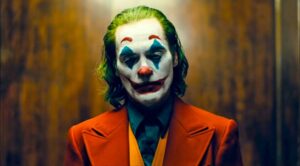
by Al Jirikowic, Washington DC Editor

Joker, the latest film by Todd Phillips, is a work of art. All the characters carry modern American ‘allegorical weight’. They are metaphorical constructs. I saw compounded layers of inherent mental-social problems, the deft compilation of ‘mental glazes’ layered, as a fine Renaissance painting presents itself, as the actors intimated — simultaneously building cross-referential thematic tracing up and through the movie itself. A dazzling web of complex, unfolding forms, each scene compelling. A wholly relational metaphor. Joker can be discussed as a form of a compacted-complete multi-imaged abstract. That, of course, is not to say the linear depiction of its plot is not important. It mirrors our society, a fragile, psychotic disturbed mess. Todd Phillips masterfully disguised Joker as a pop-cultural comic book, his conceit to get us to come to the theater, to lure us into a house of American mirrors.
The movie sets itself in 1970s Gotham, (i.e. New York) during a garbage strike. Piles of uncollected trash everywhere set the tone of discarded waste. Our tragic-hero, Arthur Fleck (as fleck of dandruff), exquisitely portrayed by Joaquin Phoenix, is the butt of humiliation, a trashed, discarded individual who as a ‘clown’ struggles to find a life. His first scene of pathos finds him advertising some store with a sign he twirls about in his full clown regalia, performing his clowning for the passer-by. A group of rowdy kids steal his sign from him, he gives chase, follows them into an alley and… WHAM he is knocked out by the kids, sign destroyed, lying flat on his back in the alley. He later reports his sign lost and he is charged for it. No chance of understanding from his heartless boss. This pattern of degradation builds throughout the movie.
Our exploration of Arthur leads us to discover that his mother, whom he takes care of, is not his mother as she claims. He, in fact, is an orphan. This discovery is gradually unearthed as he investigates the person his ‘mother’ claims to be his father. The man with whom she allegedly had an affair, Thomas Wayne is the rich plutocrat of Gotham. He believes his mother had disclosed, in a letter he intercepts, that the greatest humanitarian philanthropist leader of Gotham, is his father. Not only do we find out that Thomas Wayne is not his father but we also discover that he is in fact an overstuffed ego maniac.
The people Arthur could count on are fake. We see a pathetic society devoid of trust or fellowship. Of course, one of his clown friends lays a gun on him, so he can protect himself. Arthur commits a capital crime of self-defense. He shoots three tormenting young suited-up drunk stockbrokers after they attack him. Of course he is in his clown makeup. Of course he is seen. All of Gotham is horror-struck by the subway clown shooter. He becomes an overnight clown sensation with the people. As Gotham becomes full of clown-dressed citizens celebrating and identifying with the clown murderer – we know Todd Phillips is presenting the ‘people’ as a clown — there is never a clown by himself – and Arthur is now their hero – he is the Gotham Joker.
The clown or fool is a complex and mixed metaphor throughout theatrical history. On a very simple level, the fool is entertaining. On a more dramatic level, the jester is a tool of disclosure and truth. Our fool Arthur, our Joker, our dispeller of social convention brings us what we all know and constantly avoid. One hard revelation after another and the Joker is characterized as being mentally ill.
On the Murray Franklin show, which he dreams of being on, he fails miserably. Arthur pronounces he has been humiliated and then promptly blows Murray’s head off. Having been taken into custody, Arthur is again saved as roving rioting crowds of clowns pull him from the wrecked police car. The clowns, both pathetic and triumphant, sad and happy, victims and victimizers, are now looking at Arthur as their savior.
I would like to pay special attention to Joaquin Phoenix who brings a special mystery to the movie. One of the most captivating aspects of Joaquin’s film performance is his dance of the Joker, a subjective featherlight jig he performs in the most trying of moments. I found this quite mysterious, as if he is telling us there is so much more going on. And then of course there is his special condition, one of laughing at situations that are indeed not humorous in the least, a forced laughter that is particularly effective in its dispelling and discomfiting performance; I found it utterly uncomfortable at any place it was used.
Volume 34 no 5 May / June 2020

